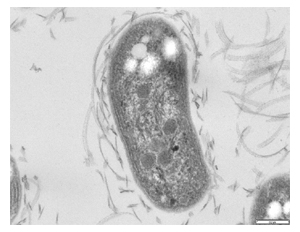Nitrobacter
genus of bacteria From Wikipedia, the free encyclopedia
Remove ads
The genus Nitrobacter consists of gram-negative (gram staining negative) bacteria with pear-shaped or different-sized rod shapes. Their size is around 0.5-0.9um in width and 1.0-2.0 um in length. The optimal growth temperature is between 28 and 30 °C, and the optimal pH is 7.5 ~8.0.[1]

Nitrobacter bacteria reproduce by separating a body into two new parts (binary fission) or by budding (when new individuals develop from parent organisms).[1] Nitrobacter grow at a quite slow rate.[2]
Nitrobacter spp. generally occur in soil and water and are organisms that derive energy from chemical reactions (chemoautotrophic). They possess compartments inside their cells, which contain a specific type of protein (enzyme nitrite oxidoreductase.[3]
Nitrobacter bacteria are responsible for the conversion (oxidation) of nitrite (NO2−) to nitrate (NO3-).[4] The chemical reaction is shown below.[5] This reaction is called nitrification and it is coupled with low rates of carbon fixation via the Calvin cycle.[6]
Nitrification benefits plant growth and is important to the ocean, as it takes about half of the nitrate consumed by phytoplankton (microscopic marine algae) growth.[7] However, it also may lead to eutrophication (enriching the water with nutrients, generally nitrogen/phosphorus) and drinking water pollution.[4]
In the presence of oxygen, Nitrobacter bacteria use nitrite as the energy source and utilize carbon dioxide as the main source of carbon. Nitrobacter bacteria can also carry out anaerobic respiration (without oxygen) by reducing nitrate to nitrite, nitric oxide (NO) and nitrous oxide (N₂O).[1]
Remove ads
History
Wikiwand - on
Seamless Wikipedia browsing. On steroids.
Remove ads

![{\displaystyle {\mathrm {NO} {\vphantom {A}}_{\smash[{t}]{2}}{\vphantom {A}}^{-}{}+{}\mathrm {H} {\vphantom {A}}_{\smash[{t}]{2}}\mathrm {O} {}\mathrel {\longrightarrow } {}\mathrm {NO} {\vphantom {A}}_{\smash[{t}]{3}}{\vphantom {A}}^{-}{}+{}2\,\mathrm {H} {\vphantom {A}}^{+}{}+{}2\,\mathrm {e} {\vphantom {A}}^{-}}}](http://wikimedia.org/api/rest_v1/media/math/render/svg/097776b88f299f4920e9fe1f8a2f6d2f8d5414b4)